|
San
Francisco
Ballet's
Next@90
Festival
of
new
works
finished
with
Program
C,
another
trio
of
pleasant
surprises.
The
festival
had
a
major
theme:
what
does
the
future
of
classical
ballet
promise
to
look
like?
My
overall
impression
of
the
nine
new
works
presented
in
three
evenings
was
inconclusive.
While
there
was
no
work
that
shattered
the
tried
and
true
of
neo-classical
and
contemporary
styles,
a
glimpse
of
the
future
of
ballet
was
manifest
in
its
relative
diversity.
Each
program
had
at
least
one
black
and
one
female
choreographer.
(Program
A
even
showed
off
two
black
male
dancemakers,
reviewed
last
month.)
Program C: Schreier, Blanc, Possokhov
Kin
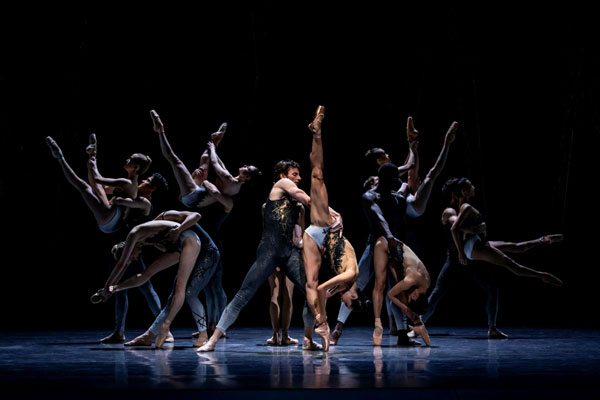
The one black female choreographer of the festival was Claudia Schreier, a
Stanford-schooled and Harvard-educated dancer who became
Choreographer in Residence at Atlanta Ballet. Schreier's creation Kin showed considerable self-confidence in moving twelve dancers plus two
couples across the stage in fast, edgy formations, using adventurous lifts,
throws and turns from ice skating – a refreshing spice. The backdrop was a
disappointing abstracted forest of planks; the music was a written for Kin by young Californian composer and song writer Tanner Porter. The partly
illustrative and at times bombastic modes of Porter's score were mainly
ignored by the abstract, athletic, rhythm-based choreography. A vague
story line flickered in and out: one "leader" of the group, elegant Wanting
Zhao, clashed with an apparent outsider, Dores Andé, who was fiercely
determined to enter the group. She finally seemed to make it, receiving a
welcome kiss from Zhao, but nevertheless ended up alone onstage, making
me wonder about a possible "Blood is thicker than water" allusion. In other
words: a kiss doesn't make you kin.
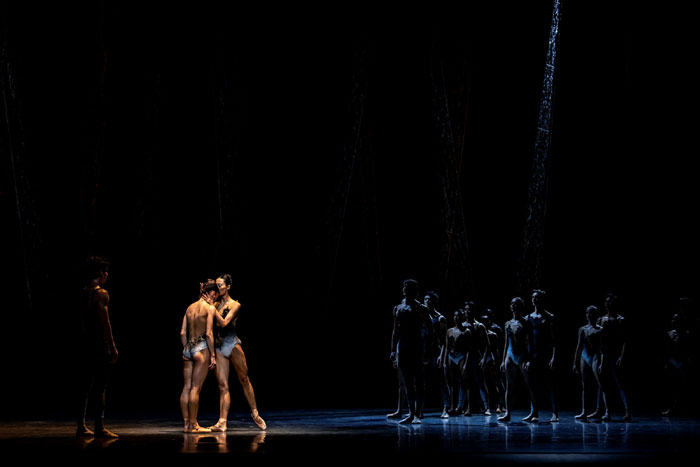
Both women danced with passion and were passionately partnered by
Aaron Robison and Isaac Hernandez, but their role in the struggle
remained obscure. The mix of abstract dance and story line didn't gel – a
problem that showed up in a number of this festival's creations. Perhaps
Schreier didn't have time to fully develop her themes and thus left the
impression of a promising draft.
Gateway to the Sun
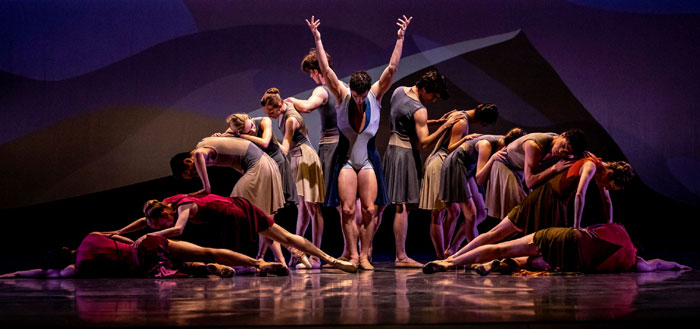
Fully controlled and mature, by comparison, was Gateway to the Sun by
French choreographer Nicolas Blanc. Blanc is an ex-Principal of SF Ballet,
who started creating pieces for the SF Ballet School then the Joffrey Ballet
where he worked as Principal and rehearsal director. In order to bring
maximum diversity to his creation for Next@90 he chose women for his
creative team, in particular Grammy-nominated composer Anna Clyne.
Her composition, "Dance," is lyrical and emotionally evocative – a perfect
foil for the purpose of the choreographer. Gateway to the Sun is both
abstract and narrative, "telling" about the awakening of the poet Rumi in
the Persian desert of the 14th century.
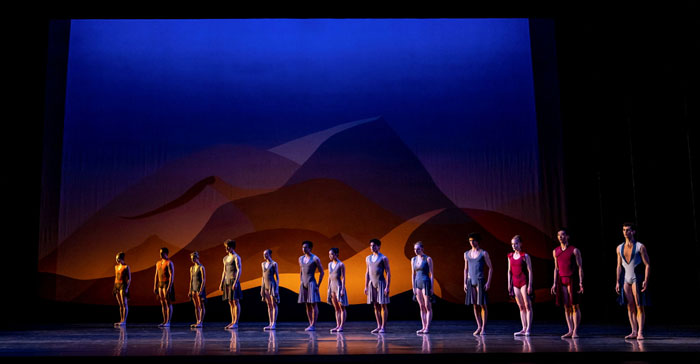
Sounds of wind and sand begin the piece. Cut into the black backdrop is a
sliver of desert, bathed in sunlight, and the dancers are seen in silhouette,
standing staring into the desert, slightly shifting to one side, then the other.
The group begins to dance. The Poet (Max Cauthorn) approaches a male
dancer and lays his head against his back as if to listen to the man's inner
life. This gesture of "soul searching" and the ensuing dance evokes the
relationship Rumi found with the dervish Shams-e Tabrizi that changed
him from Islamic teacher to mystic and engendered his most passionate
poetry.
From the moment of listening in, the two men danced, joined by the group,
and the backdrop opened to the full, glowing desert hills. The costumes –
knee-length skirts with an open front for everyone – added their strangely
archaic, even biblical associations to the ritual and tribal atmosphere of the
piece. In beautiful ways, Blanc showed the power of the poet as a
prophet/teacher, but also the outsider. He appeared and disappeared and
assisted couples in discovering love while apparently also learning about
love himself. Blanc was exquisitely served by the artistry of Principal Max
Cauthorn who exuded both a strong muscular masculinity and feminine,
lyrical attunement. The perfect simplicity of this narrative line filled the
work with existential warmth and meaning – just the thing Claudia
Schreier and others in this festival reached for but did not quite grasp.
Violin Concerto
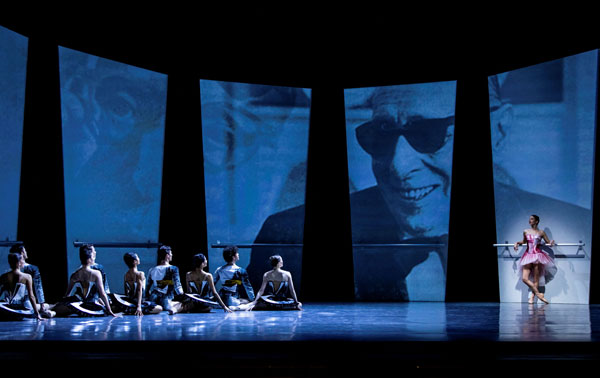
Yuri Possokhov, Russian Choreographer in Residence of SF Ballet, was the
second dancemaker of the festival who boldly took on an iconic
masterpiece from the past and made it his own. The first one had been
Yuka Oishi (Program B) with her take on Béjart's Bolero by Ravel
(reviewed last month). Possokhov took on Balanchine's famous Violin
Concerto by Stravinsky. Instead of the fiercely controlled symmetries of
Balanchine's eight elegant dancers, we got a happy cavalcade of sixteen,
plus one "Muse" cavorting in and out of an illusionary dance studio. There
were no straight lines, no architectural groupings in this version . Even the
barre at the back was curved. Six partitions divided the back wall showing
slide projections of the composer and his score. It was a marvelous effect to
see Stravinsky peer bug-eyed from behind his glasses like a deity watching
his little children play with his tricky rhythms.
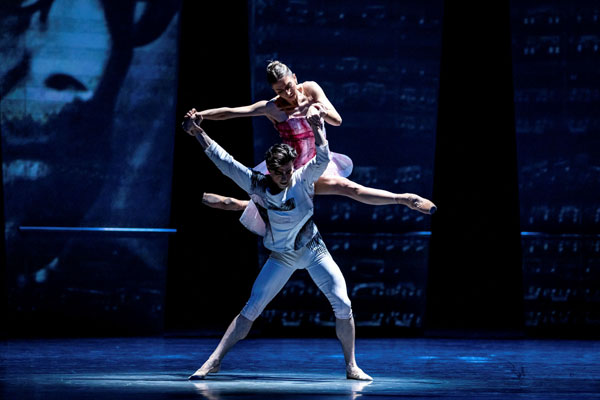
The constant entrances and exits were full of lively, inventive moves, leaps
and lifts, perfectly suited to the music, which was no surprise given this
choreographer's great musicality. The merry chaos got organization and
accents from the Muse: she snowed in with her gauzy, tiered pink tutu like
a summer breeze, drove the male dancers on, then stood still at the barre
like the emissary of the composer keeping watch. At one point she
interfered in a pas de deux as if quoting from the romantic ballet La
Sylphide in the original French version from 1832. Only Possokhov, who
has known every dancer intimately for over a decade, could have made the
inspired choice of Sasha Mukhamedowfor the Muse -- a corps member
with an earnest unpretentious confidence and aplomb. She needed no extra
dose of charm or smiles to be a delight.
Now the suspense remains: which of the nine new world premieres of
Next@90 will make it inti the SF Ballet repertoire? This will be up to the
new artistic director, Tamara Roja. Yuka Oishi's bold Bolero is on top of my
list together with Jamar Roberts's edgy Resurrection (see last month) and
Nicolas Blanc's poetic Gateway to the Sun. And I count on Possokhov,
hoping to see an elaboration of certain ideas like the intriguing but
underused barre. It will be rewarding to see his slightly chaotic exuberance
evolve into a more transparent architectural form.
Giselle

Interestingly, this year's festival of new works did not showcase a successful
narrative piece of work, and so it was a pleasure to dive back into the past
with Giselle, a full-throttle narrative ballet. Helgi Tomasson's version of the
romantic classic leaves most of the tradition intact. His sets recall a
children's pop-up book: a German village square with a rustic house and a
castle in the distance. In Act II, a gnarly forest that opens to a lighting with
Giselle's grave. Nothing more is needed to set the story of the village girl
betrayed by her suitor, a prince in disguise. Losing her mind and dying
from a broken heart, she returns as one of the "Wilis"– nightly spirits of
dead maidens betrayed before marriage.
All the great romantic ballets are about love and death, betrayal and
forgiveness. La Sylphide (1832), Giselle (1841) or latecomer Swan Lake
(1875) share otherworldly elements, fiendish challenges for the dancers,
and high demands in acting and miming. The most demanding is Giselle
because of the triple aspects of the heroine: dance-loving, but fragile village
girl, heart-broken mad girl, and all-forgiving ghostly lover. It's a career
-defining role and great ballerinas are often remembered as "one of the
most devastating Giselles."
SF Ballet has had a long line of Giselles since artistic director Helgi
Tomasson presented his version in 1999. He usually let five or six of his
dancers take the lead in a run of a good dozen performances. I've been
lucky to see a few of the "most devastating" Giselles: Yuan Yuan Tan and
Lorena Feijoo (reviewed in these pages). This year I was able to add a third
candidate: the new Principal Misa Kuranaga. I saw an exquisite excerpt of Giselle at the opening Gala, and learned on YouTube that the Japanese
dancer could not make it in the West until she decided to develop a
specialty: pirouettes. Turns on pointe are the most tricky moves in the
classic vocabulary. Kuranaga demonstrates in the video the astonishing
perfection she attained, which opened the doors for her.
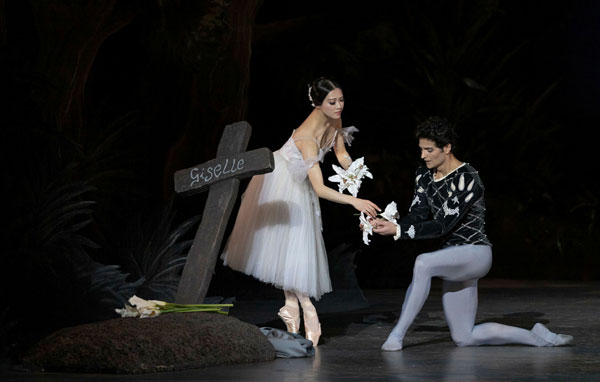
Kurnaga displayed artistry in every aspect of the role. She was a lovely, shy,
sensitive village girl, turned ferocious in the mad scene, and in the long
second act, turned diaphanous, a white, weightless, floating soul. Her
technique seemed effortless, carried by musicality and sincere, convincing
emotion.
Albrecht, her prince, was Angelo Greco, a fine dancer with very long limbs
whose leaps seemed to push against the limits of the stage space. He had an
air of pushing boundaries with youthful exuberance that made him
sympathetic even in his betrayal. Greco and Kuranaga achieved a rousing
crescendo when she helped him not to succumb to his punishment by the
Wilis: having to dance himself to death. When the church bells strike
morning and the nightly spook ends he is still alive, thanks to Giselle's love.
Their separation at her grave had the depth of grief and transcendent
tenderness that felt… well, devastating.
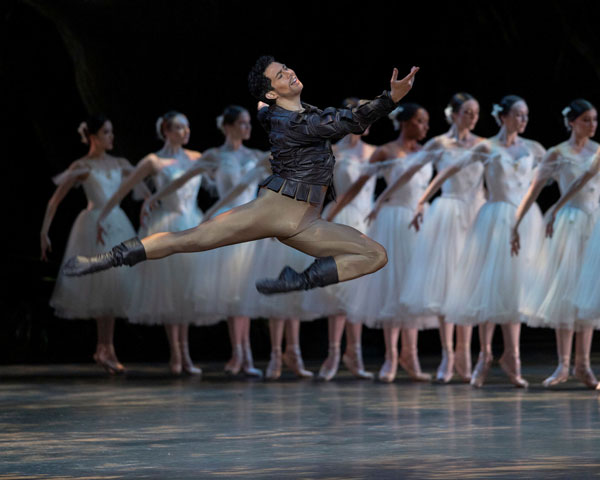
The secondary character of the village hunter Hilarion was flawlessly
danced by Steven Morse, but his character was watered down to "just
another nice guy in love with Giselle" which is a dramaturgical mistake.
Hilarion is supposed to bring a dark and threatening note to the fairytale
(and the illustrative music by Adolphe Adam leaves no doubt about it). A
"nice-guy" Hilarion can unbalance the tale unnecessarily by outshining
Prince Albrecht and making the audience wish she had chosen him instead.
Myrtha, queen of the Wilis, was danced by Principal Jennifer Stahl,
technically perfect, but strangely and uncharacteristically stiff in her arms
and torso. If this was an attempt to radiate Myrtha's rigid authority, it was a
misjudgment. The extensive passages when she calls up the maiden spirits
in their bridal veils, and finally calls Giselle from her grave, are supposed to
set the mood for mysteries and introduce the magic of wafting spirits. Her
severity has to come later, when the male intruders, Hilarion and Albrecht,
disrupt their melancholy rituals. One only has to look at other classical
versions, the Bolshoi Giselle, for example, to feel sorry about what was
missed in this interpretation.

No matter, the group of the Wilis, corps members and soloists, provided
plenty of magical grace. The famous passage when they enter, six at a time,
and cross the stage with tiny hops in arabesque, holding their lines in
perfection until they fill the whole stage, was admirable and brought the
house down with the excitement of witnessing the almost impossible – a
romantic ideal.
Photos - Lindsay Thomas
|